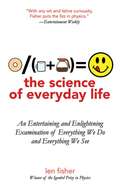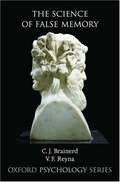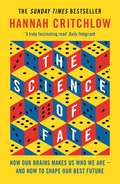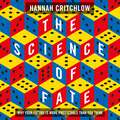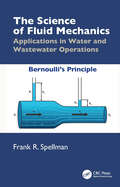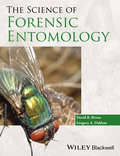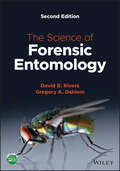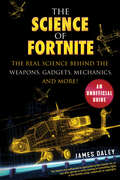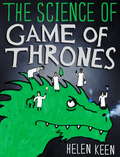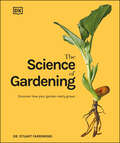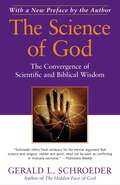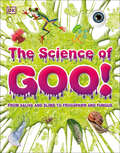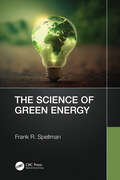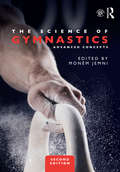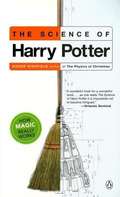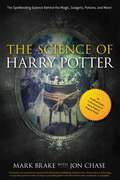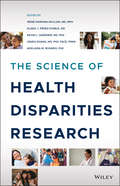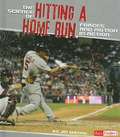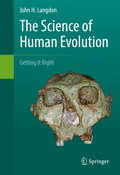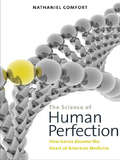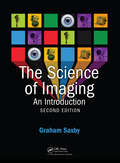- Table View
- List View
The Science of Everyday Life: An Entertaining and Enlightening Examination of Everything We Do and Everything We See
by Len FisherScientists are in the business of trying to understand the world. Exploring commonplace phenomena, they have uncovered some of nature's deepest laws. We can in turn apply these laws to our own lives, to better grasp and enhance our performance in daily activities as varied as cooking, home improvement, sports--even dunking a doughnut! This book makes the science of the familiar a key to opening the door for those who want to know what scientists do, why they do it, and how they go about it. Following the routine of a normal day, from coffee and breakfast to shopping, household chores, sports, a drink, supper, and a bath, we see how the seemingly mundane can provide insight into the most profound scientific questions. Some of the topics included are the art and science of dunking; how to boil an egg; how to tally a supermarket bill; the science behind hand tools; catching a ball or throwing a boomerang; the secrets of haute cuisine, bath (or beer) foam; and the physics of sex. Fisher writes with great authority and a light touch, giving us an entertaining and accessible look at the science behind our daily activities.
The Science of False Memory (Oxford Psychology Series #38)
by V. F. Reyna C. J. BrainerdFindings from research on false memory have major implications for a number of fields central to human welfare, such as medicine and law. Although many important conclusions have been reached after a decade or so of intensive research, the majority of them are not well known outside the immediate field. To make this research accessible to a much wider audience, The Science of False Memory has been written to require little or no background knowledge of the theory and techniques used in memory research.
The Science of Fate: The New Science of Who We Are - And How to Shape our Best Future
by Hannah Critchlow**THE SUNDAY TIMES BESTSELLER**'A truly fascinating - if unnerving - read'DAILY TELEGRAPH'Acute, mind-opening, highly accessible - this book doesn't just explain how our lives might pan out, it helps us live better'BETTANY HUGHES'A humane and highly readable account of the neuroscience that underpins our ideas of free will and fate'PROFESSOR DAVID RUNCIMAN***So many of us believe that we are free to shape our own destiny. But what if free will doesn't exist? What if our lives are largely predetermined, hardwired in our brains - and our choices over what we eat, who we fall in love with, even what we believe are not real choices at all? Neuroscience is challenging everything we think we know about ourselves, revealing how we make decisions and form our own reality, unaware of the role of our unconscious minds. Did you know, for example, that:* You can carry anxieties and phobias across generations of your family?* Your genes and pleasure and reward receptors in your brain will determine how much you eat?* We can sniff out ideal partners with genes that give our offspring the best chance of survival?Leading neuroscientist Hannah Critchlow draws vividly from everyday life and other experts in their field to show the extraordinary potential, as well as dangers, which come with being able to predict our likely futures - and looking at how we can alter what's in store for us. Lucid, illuminating, awe-inspiring The Science of Fate revolutionises our understanding of who we are - and empowers us to help shape a better future for ourselves and the wider world.
The Science of Fate: The New Science of Who We Are - And How to Shape our Best Future
by Hannah CritchlowThe Sunday Times Top Ten Bestseller'A truly fascinating - if unnerving - read'The Telegraph'We can all benefit from Critchlow's book'New Scientist'Acute, mind-opening, highly accessible - this book doesn't just explain how our lives might pan out, it helps us live better'Bettany Hughes'A humane and highly readable account of the neuroscience that underpins our ideas of free will and fate'Professor David RuncimanSo many of us believe that we are free to shape our own destiny. But what if free will doesn't exist? What if our lives are largely predetermined, hardwired in our brains - and our choices over what we eat, who we fall in love with, even what we believe are not real choices at all? Neuroscience is challenging everything we think we know about ourselves, revealing how we make decisions and form our own reality, unaware of the role of our unconscious minds. Did you know, for example, that:* You can carry anxieties and phobias across generations of your family?* Your genes and pleasure and reward receptors in your brain will determine how much you eat?* We can sniff out ideal partners with genes that give our offspring the best chance of survival?Leading neuroscientist Hannah Critchlow draws vividly from everyday life and other experts in their field to show the extraordinary potential, as well as dangers, which come with being able to predict our likely futures - and looking at how we can alter what's in store for us. Lucid, illuminating, awe-inspiring The Science of Fate revolutionises our understanding of who we are - and empowers us to help shape a better future for ourselves and the wider world.
The Science of Fate: The New Science of Who We Are - And How to Shape our Best Future
by Hannah CritchlowAre we really the masters of our own destiny? Neuroscientist Hannah Critchlow shows how far our future is already hardwired in our brains. Like Sapiens and Thinking Fast and Slow, The Science of Fate revolutionises the way we understand our species and ourselves.So many of us believe that we are free to shape our own destiny. But what if free will doesn't exist? What if our lives are largely predetermined, hardwired in our brains - and our choices over what we eat, who we fall in love with, even what we believe are not real choices at all? Neuroscience is challenging everything we think we know about ourselves, revealing how we make decisions and form our own reality, unaware of the role of our unconscious minds. Did you know, for example, that:* You can carry anxieties and phobias across generations of your family?* Your genes and pleasure and reward receptors in your brain will determine how much you eat?* We can sniff out ideal partners with genes that give our offspring the best chance of survival?Leading neuroscientist Hannah Critchlow draws vividly from everyday life and other experts in their field to show the extraordinary potential, as well as dangers, which come with being able to predict our likely futures - and looking at how we can alter what's in store for us. Lucid, illuminating, awe-inspiring The Science of Fate revolutionises our understanding of who we are - and empowers us to help shape a better future for ourselves and the wider world.(P)2019 Hodder & Stoughton Limited
The Science of Fluid Mechanics: Applications in Water and Wastewater Operations
by Frank R. SpellmanThe Science of Fluid Mechanics: Applications in Water and Wastewater Operations examines the intricacies of hydrology and hydraulic systems within the context of water and wastewater management. Written in an academic yet easy-to-understand style, the book provides a comprehensive overview of relevant topics of fluid mechanics. With a wealth of illustrations and exercises, it caters to students, operators, and plant managers, offering clear explanations of quantitative elements essential to understanding water resource development and treatment. Covering foundational principles of fluid mechanics, hydraulics, and related practical applications, the book serves as a valuable resource for those seeking to deepen their knowledge in the field. Provides the basic principles required to understand fluid mechanics/hydraulic engineering Explains the main concepts of water and wastewater management and operations Includes numerous illustrations and exercise problems in each chapter
The Science of Forensic Entomology
by Gregory A. Dahlem David B. RiversThe Science of Forensic Entomology builds a foundation of biological and entomological knowledge that equips the student to be able to understand and resolve questions concerning the presence of specific insects at a crime scene, in which the answers require deductive reasoning, seasoned observation, reconstruction and experimentation--features required of all disciplines that have hypothesis testing at its core. Each chapter addresses topics that delve into the underlying biological principles and concepts relevant to the insect biology that forms the bases for using insects in matters of legal importance.The book is more than an introduction to forensic entomology as it offers in depth coverage of non-traditional topics, including the biology of maggot masses, temperature tolerances of necrophagous insects; chemical attraction and communication; reproductive strategies of necrophagous flies; archaeoentomology, and use of insects in modern warfare (terrorism). As such it will enable advanced undergraduate and postgraduate students the opportunity to gain a sound knowledge of the principles, concepts and methodologies necessary to use insects and other arthropods in a wide range of legal matters.
The Science of Forensic Entomology
by Gregory A. Dahlem David B. RiversA thoroughly updated introduction to forensic entomology In the newly revised second edition of The Science of Forensic Entomology, two distinguished entomologists deliver a foundational and practical resource that equips students and professionals to be able to understand and resolve questions concerning the presence of specific insects at crime scenes. Each chapter in the book addresses a topic that delves into the underlying biological principles and concepts relevant to the insect biology that grounds the use of insects in legal and investigational contexts. In addition to non-traditional topics, including the biology of maggot masses, temperature tolerances of necrophagous insects, chemical attraction and communication, reproductive strategies of necrophagous flies, and archaeoentomology, the book also offers readers: A thorough introduction to the role of forensic science in criminal investigations and the history of forensic entomology Comprehensive discussions of the biology, taxonomy, and natural history of forensically important insects Fulsome treatments of the postmortem decomposition of human remains and vertebrate carrion In-depth introduction to the concepts of accumulated degree days and the use of insect development for estimation of the postmortem interval New chapters dedicated to forensic entomotoxicology, aquatic insects in forensic investigations, microbiomes of forensic insects and carrion, professional standards, and case studies Perfect for graduate and advanced undergraduate students in forensic entomology, forensic biology, and general forensic science, The Science of Forensic Entomology will also earn a place in the libraries of law enforcement and forensic investigators, as well as researchers in forensic entomology
The Science of Fortnite: The Real Science Behind the Weapons, Gadgets, Mechanics, and More!
by James DaleyDiscover the science behind the Fortnite phenomenon! Drawing in more than a hundred million players in its first year of existence, Fortnite's crazy mix of intense combat, wild weapons, innovative construction mechanics, and eccentric environments has made it one of the most popular online video games in the world. A perfect gift for any Fortnite fan, The Science of Fortnite addresses more than fifty topics that span the entire Fortnite universe! This book includes scientific discussions of many of Fortnite&’s most interesting gameplay details, including: The islandThe battle busTrapsGadgetsWeaponsSchematicsBuildingThe storm This book will discuss how many of the game&’s most fantastical weapons might actually work, how the player-made structures would or wouldn&’t stand up to the stress of battle, and what the deal is with that huge purple storm! Whether you&’re a fan of Battle Royale, Save the World, or Creative play, The Science of Fortnite will entertain and enlighten you with the scientific truths behind this amazing game.
The Science of Game of Thrones: A myth-busting, mind-blowing, jaw-dropping and fun-filled expedition through the world of Game of Thrones
by Helen KeenA myth-busting, mind-blowing, jaw-dropping and fun-filled expedition through the world of Game of Thrones.Do dragons actually exist? Is it possible to crush a person's head with your bare hands?What really happened when royal families interbreed? How does wildfire win wars? Can you really kill someone with molten gold?Award-winning comedian and popular-science writer Helen Keen uncovers the astounding science behind the world's most popular television show. Join Helen as she sifts the fact from fantasy, discovers the truth beneath the togas, and reveals a world more fantastical than Daenerys Targaryen's wildest dreams. So pour yourself a bowl of brown, climb on your beast of burden, and prepare yourself for an amazing adventure. It's time to see the Seven Kingdoms as you have never seen them before.
The Science of Gardening: Discover How Your Garden Really Works
by Dr. Stuart FarrimondExploding myths and providing key takeaway advice for gardeners at any level, this book provides a shortcut to decades of gardening experience by explaining the science behind how a garden grows.How often should I water my plants? What&’s the most effective slug deterrent? Could I breed my own unique variety of flower? Do plants have intelligence? Does it really matter when and how I prune? And why is my compost heap so slimy? If you find yourself seeking the answers to these questions and many more, then this may be the book for you!The world of gardening can be a mystifying place, with so many instructions to follow and often little explanation as to why. Dr Stuart Farrimond casts his scientific eye over the garden to answer all the horticultural questions you&’ve ever wondered about.Get your gardening gloves on and dive straight in to discover:- An accessible guide structured around the life cycle of the garden, taking you from first shoots to pruning for renewal.- An accessible Q &A format, with stats and infographics to bring the story to life, as well as long-held gardening myths are exploded by new science.- Every way to greener fingers has action points so that you can understand the science, apply your gardening practice, and enjoy a flourishing garden.From hands-on, practical advice, to an exploration of the mental health benefits of gardening, whilst also covering topics such as the positive impact gardening can have on the earth during a time of climate crisis, The Science of Gardening debunks myths, and reveals the latest science often only taught at horticultural college. As a passionate newcomer to gardening, daunted by the mountain of often conflicting advice in gardening manuals, Dr Stuart Farrimond has set about testing the scientific basis of so much conventional wisdom and practice so you too can garden like a pro.A must-have gardening book for keen beginners with a passion for plants but who are daunted by the prospect of trawling through traditional gardening manuals for explanations, as well as experienced gardeners who are intrigued to find out the theory behind their practice and who want to improve on where they might be getting something wrong.At DK, we believe in the power of discovery. So why stop there? If you like Science of Gardening, then why try Science of Cooking or Science of Spice to complete the collection.
The Science of God: The Convergence of Scientific and Biblical Wisdom
by Gerald L. SchroederFor the readers of The Language of God, another instant classic from "a sophisticated and original scholar" (Kirkus Reviews) that disputes the idea that science is contrary to religion.In The Science of God, distinguished physicist and Biblical scholar Gerald L. Schroeder demonstrates the surprising parallels between a variety of Biblical teachings and the findings of biochemists, paleontologists, astrophysicists, and quantum physicists. In a brilliant and wide-ranging discussion of key topics that have divided science and religion--free will, the development of the universe, the origin of life, and the origin of man--Schroeder argues that the latest science and a close reading of the Bible are not just compatible but interdependent. This timely reissue of The Science of God features a brand-new preface by Schroeder and a compelling appendix that addresses the highly publicized experiment in 2008 in which scientists attempted to re-create the chemical composition of the cosmos immediately after the Big Bang. It also details Schroeder's lucid explanations of complex scientific and religious concepts, such as the theory of relativity, the passage of time, and the definitions of crucial Hebrew words in the Bible. Religious skeptics, Biblical literalists, scientists, students, and physicists alike will be riveted by Schroeder's remarkable contribution to the raging debate between science and religion.
The Science of Golf: The Math, Technology, and Data
by Will HaskettThe perfect gift for golf enthusiasts of all experience levels! InThe Science of Golf, seasoned sports broadcaster Will Haskett examines the science behind the beloved sport of golf. The author covers topics like the swing, the body, the mind, the equipment, the agronomy of the course, analytics, and much more. Haskett explains what makes the ball fly, how different swings can accomplish the same result, why different playing fields impact each shot, and how a rapid improvement in technology has made the sport easier and more accessible. With insight from industry experts, sports scientists, and some of golf&’s best minds, this book may surprise golf gurus and science geeks alike!
The Science of Goo!: From Saliva and Slime to Frogspawn and Fungus (DK 1,000 Amazing Facts)
by DKGet to grips with the glorious world of goop and gunk, from pus, snot, and mucus to mud, snail slime, and sticky plants, in this compendium of gunk.If you've ever wondered how much snot you make, or how spider silk is made, this is the book for you. Full of strange but true science, The Science of Goo! explores all manner of gunge, sludge, ooze, and goo! Awesome CGI illustrations and stunning photography will show goo in all its glory, while fun trivia and scientific explanations will make you an expert in all things sludgy. For example, did you know that sea cucumbers can vomit their sticky insides when threatened, yet still survive? The Science of Goo! is here to give you a new appreciation of the weird and wonderful world of gooey matter, in all its many kinds and wherever it shows up.
The Science of Green Energy
by Frank R. SpellmanConcern for the environment and the impacts of pollution have brought about the need to shift from the use and reliance on hydrocarbons to energy-power sources that are pollution neutral or near pollution neutral or renewable. Moreover, the impact of 200 years of industrialization and surging population growth threatens to exceed the future supply of hydrocarbon power sources. Therefore, the implementation of green energy sources is surging. The Science of Green Energy presents technologies and techniques, as well as real-world usage of and operation of today’s green energy-based applications. This practical book is designed to be used as an information source for the general reader, or for a course in energy, chemistry or in renewable energy engineering fields where green energy is becoming a key player. It is intended to fill a wide gap of missing information in published texts dealing with the green energy revolution currently in progress; it specifically provides information involving the many different sources of energy.
The Science of Gymnastics: Advanced Concepts
by Monèm JemniThe Science of Gymnastics provides the most comprehensive and accessible introduction available to the fundamental physiological, biomechanical and psychological principles underpinning performance in artistic gymnastics. The second edition introduces three new sections: applied coaching, motor learning and injury prevention and safety, and features contributions from leading international sport scientists and gymnastics coaches and instructors. With case studies and review questions included in each chapter, the book examines every key aspect of gymnastic training and performance, including: physiological assessment diet and nutrition energetics kinetics and kinematics spatial orientation and motor control career transitions mental skills training and perception injury assessment and prevention, with clinical cases advanced case studies in rotations, vault approach and elastic technologies in gymnastics. A fully dedicated website provides a complete set of lecture material, including ready-to-use animated slides related to each chapter, and the answers to all review questions in the book. The book represents an important link between scientific theory and performance. As such, The Science of Gymnastics is essential reading for any student, researcher or coach with an interest in gymnastics, and useful applied reading for any student of sport science or sports coaching.
The Science of Hair Care
by John Wilkinson Claude BouillonThe most comprehensive source on the subject, this Second Edition is completely revised and expanded to reveal the most recent advances, technologies, and trends in hair and hair care science-tracking the development of hair care products, the emergence of new regulatory practices, and the latest methods in product safety and efficacy assessment.
The Science of Harry Potter
by Roger HighfieldCan Fluffy the three-headed dog be explained by advances in molecular biology? Could the discovery of cosmic "gravity-shielding effects" unlock the secret to the Nimbus 2000 broomstick's ability to fly? Is the griffin really none other than the dinosaur Protoceratops? Roger Highfield, author of the critically acclaimed The Physics of Christmas, explores the fascinating links between magic and science to reveal that much of what strikes us as supremely strange in the Potter books can actually be explained by the conjurings of the scientific mind. This is the perfect guide for parents who want to teach their children science through their favorite adventures as well as for the millions of adult fans of the series intrigued by its marvels and mysteries.
The Science of Harry Potter: The Spellbinding Science Behind the Magic, Gadgets, Potions, and More! (The Science of Series)
by Mark Brake Jon ChaseHow does magic in J. K. Rowling’s universe work? Finally, the scientific secrets are revealed!The story of the boy who lived has brought the idea of magic and sorcery into mainstream fruition more than any other book series in history. Modern muggle scientists have uncovered explanations to the seemingly impossible, including answers to such questions as: Will we ever see an invisibility cloak? How hazardous is a flying broomstick like the Nimbus 2000? How has medicine made powerful potions from peculiar plants? (Felix Felicis, anyone?) Can scientists ever demonstrate Wingardium Leviosa, or the flying power of a Golden Snitch? Is it possible to stupefy someone? And many more!Often perceived as a supernatural force, magic captivates and delights its audience because of its seeming ability to defy physics and logic. But did you ever wonder if science has any explanation for these fantastic feats? The Science of Harry Potter examines the scientific principles—behind some of your favorite characters, spells, items, scenes, and even games like Quidditch and Wizard’s Chess—from boy wizard Harry Potter’s world, providing in-depth analysis and scientific facts to support its theories. Author Mark Brake, whose The Science of Star Wars was a knockout success, has found the answers to satisfy the curious spirits of muggles everywhere…A perfect Harry Potter gift for anyone obsessed enough to stand in line to be the first to see Harry Potter and the Cursed Child or Fantastic Beasts and Where to Find Them, witches and wizards alike will be fascinated by the merging of this improbable realm and real science!
The Science of Health Disparities Research
by Irene Dankwa-Mullan Xinzhi Zhang Adelaida M. Rosario Kevin L. Gardner Eliseo J. Pérez-StableIntegrates the various disciplines of the science of health disparities in one comprehensive volume The Science of Health Disparities Research is an indispensable source of up-to-date information on clinical and translational health disparities science. Building upon the advances in health disparities research over the past decade, this authoritative volume informs policies and practices addressing the diseases, disorders, and gaps in health outcomes that are more prevalent in minority populations and socially disadvantaged communities. Contributions by recognized scholars and leaders in the field—featuring contemporary research, conceptual models, and a broad range of scientific perspectives—provide an interdisciplinary approach to reducing inequalities in population health, encouraging community engagement in the research process, and promoting social justice. In-depth chapters help readers better understand the specifics of minority health and health disparities while demonstrating the importance of advancing theory, refining measurement, improving investigative methods, and diversifying scientific research. In 26 chapters, the book examines topics including the etiology of health disparities research, the determinants of population health, research ethics, and research in African American, Asians, Latino, American Indian, and other vulnerable populations. Providing a unified framework on the principles and applications of the science of health disparities research, this important volume: Defines the field of health disparities science and suggests new directions in scholarship and research Explains basic definitions, principles, and concepts for identifying, understanding and addressing health disparities Provides guidance on both conducting health disparities research and translating the results Examines how social, historical and contemporary injustices may influence the health of racial and ethnic minorities Illustrates the increasing national and global importance of addressing health disparities Discusses population health training, capacity-building, and the transdisciplinary tools needed to advance health equity A significant contribution to the field, The Science of Health Disparities Research is an essential resource for students and basic and clinical researchers in genetics, population genetics, and public health, health care policymakers, and epidemiologists, medical students, and clinicians, particularly those working with minority, vulnerable, or underserved populations.
The Science of Heroes
by Yvonne Carts-PowellA fun, fact-filled examination of the science (or lack thereof) behind the hit television series Heroes. Ordinary people with extraordinary powers populate the world of the hit television show Heroes, where characters exhibit such abilities as flight, telepathy, tissue regeneration, prognostication, invisibility, and teleportation through space and time. The Science of Heroes explores these superpowers and many more through real-world research into the potential of human physical and mental capabilities. Citing the work of renowned scientists and engineers, Yvonne Carts-Powell reveals that even the least likely of powers has been studied?and in some cases, even developed. From the wonders found in nature and cutting-edge technological achievements to the latest discoveries in genetics and mutations, humanity might just possess the knowledge to achieve the extraordinary.
The Science of Hitting a Home Run: Forces And Motion In Action (Action Science Ser.)
by Jim WhitingDescribes the science behind hitting a home run, including pitch types, different bats, and force
The Science of Human Evolution
by John H. LangdonThis textbook provides a collection of case studies in paleoanthropology demonstrating the method and limitations of science. These cases introduce the reader to various problems and illustrate how they have been addressed historically. The various topics selected represent important corrections in the field, some critical breakthroughs, models of good reasoning and experimental design, and important ideas emerging from normal science.
The Science of Human Perfection: How Genes Became the Heart of American Medicine
by Nathaniel ComfortAlmost daily we hear news stories, advertisements, and scientific reports promising that genetic medicine will make us live longer, enable doctors to identify and treat diseases before they harm us, and individualize our medical care. But surprisingly, a century ago eugenicists were making the same promises. This book traces the history of the promises of medical genetics and of the medical dimension of eugenics. While mindful of the benefits of genetic medicine, the book also considers social and ethical issues that cast troublesome shadows over these fields. Keeping his focus on America, Nathaniel Comfort introduces the community of scientists, physicians, and public health workers who have contributed to the development of medical genetics from the nineteenth century to today. He argues that medical genetics is closely related to eugenics, and indeed that the two cannot be fully understood separately. He also carefully examines how the desire to relieve suffering and to improve ourselves genetically, though noble, may be subverted. History makes clear that as patients and consumers we must take ownership of genetic medicine, using it intelligently, knowledgeably, and skeptically.
The Science of Imaging
by Graham SaxbyEdited and expanded to keep pace with the digital revolution, the new edition of this highly popular and critically acclaimed work provides a comprehensive exploration of imaging science. Brilliantly written and extensively illustrated, The Science of Imaging: An Introduction, Second Edition covers the fundamental laws of physics as well as the cut
